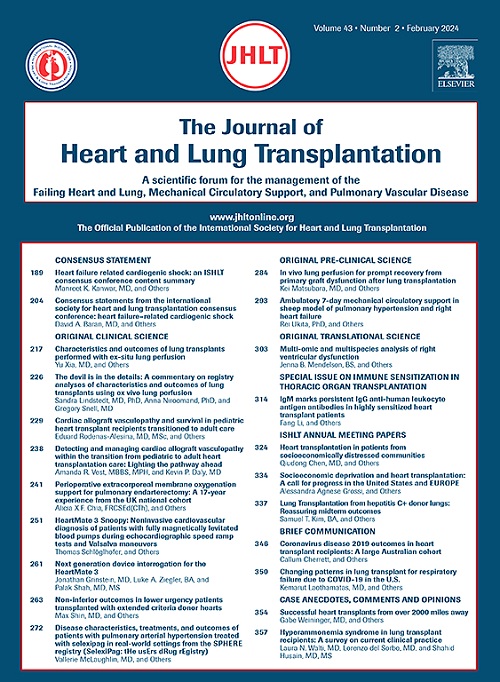心脏移植中的供体年龄和缺血时间--对器官保存的影响。
IF 6.4
1区 医学
Q1 CARDIAC & CARDIOVASCULAR SYSTEMS
引用次数: 0
摘要
导言:器官护理系统和非缺血心脏保存方法是心脏移植领域的重大进展,旨在减轻缺血损伤并延长保存时间。然而,由于其成本高昂、后勤工作复杂,有必要对其进行战略性利用:我们评估了国际心肺移植学会登记处从 1988 年到 2018 年登记的 83761 例心脏移植数据。利用 Cox 比例危险模型,我们探讨了供体年龄和缺血时间对移植存活率的影响。我们研究的一个重要创新是结合传统和先进的统计方法,开发了一个预测移植后存活率的提名图:结果:受者的中位年龄为 52 岁(22% 为女性),供者的中位年龄为 33 岁(31% 为女性)。分析显示,整个队列的中位缺血时间为 3 小时,中位存活时间为 11.5 年。提名图显示,随着捐献者年龄的增加,存活概率下降,特别是从 40 岁开始,缺血时间大于 4 小时时更明显。缺血时间≥4小时与结论:这项研究强调了谨慎选择捐献者的重要性,并表明某些群体,尤其是缺血时间较长的老年捐献者,可能会从体外保存技术中获益。所开发的提名图为临床医生提供了一个实用工具,通过详细了解供体年龄、缺血时间和移植后死亡率之间的关系,可提高决策水平。本文章由计算机程序翻译,如有差异,请以英文原文为准。
Donor age and ischemic time in heart transplantation – implications for organ preservation
Background
The Organ Care System and Non-ischemic Heart Preservation methods have emerged as significant advancements in heart transplantation, designed to mitigate ischemic injury and extend preservation times. However, their high costs and logistical complexities necessitate strategic utilization.
Methods
We evaluated data from 83,761 heart transplants registered in the International Society for Heart and Lung Transplantation registry from 1988 to 2018. Utilizing a Cox proportional hazards model, we explored the influence of donor age and ischemic time on transplant survival. A key innovation of our study is the development of a nomogram to predict post-transplant survival, incorporating both traditional and advanced statistical methods.
Results
The median age of recipients was 52 years (22% female) and 33 years (31% female) for donors. Analysis revealed a median ischemic time of 3 hours and median survival of 11.5 years across the cohort. The nomogram showed a decline in survival probabilities with increasing donor age, notably from age 40 and more significantly with ischemic times >4 hours. Ischemic times ≥4 hours versus <2 hours were associated with hazard ratio (HR) of 1.2 (95% CI, 1.1–1.3) for donors aged 40–59, a disparity that escalated for donors aged ≥60 (HR: 2.0; 95% CI, 1.5–2.7).
Conclusions
This study highlights the importance of careful donor selection and indicates that certain groups, particularly older donors with prolonged ischemic times, might benefit from ex-vivo preservation techniques. The developed nomogram offers a practical tool for clinicians, enhancing decision-making by providing detailed insights into the relationship between donor age, ischemic time, and post-transplant mortality.
求助全文
通过发布文献求助,成功后即可免费获取论文全文。
去求助
来源期刊
CiteScore
10.10
自引率
6.70%
发文量
1667
审稿时长
69 days
期刊介绍:
The Journal of Heart and Lung Transplantation, the official publication of the International Society for Heart and Lung Transplantation, brings readers essential scholarly and timely information in the field of cardio-pulmonary transplantation, mechanical and biological support of the failing heart, advanced lung disease (including pulmonary vascular disease) and cell replacement therapy. Importantly, the journal also serves as a medium of communication of pre-clinical sciences in all these rapidly expanding areas.

 求助内容:
求助内容: 应助结果提醒方式:
应助结果提醒方式:


